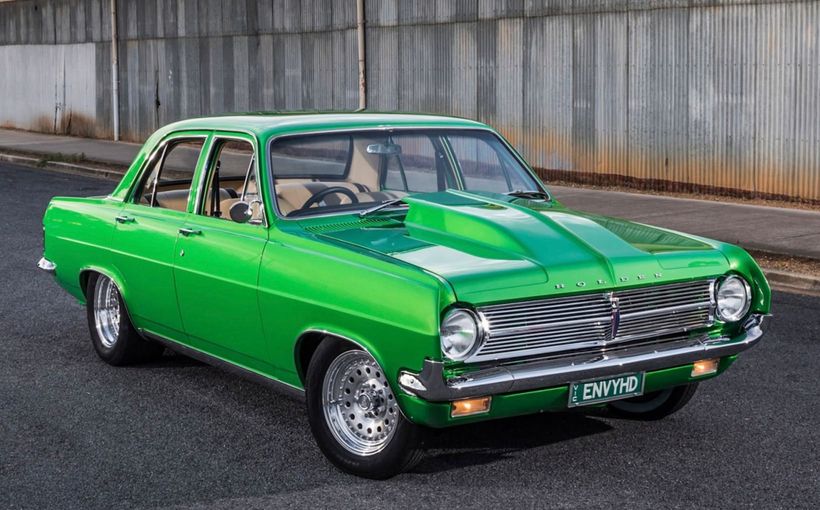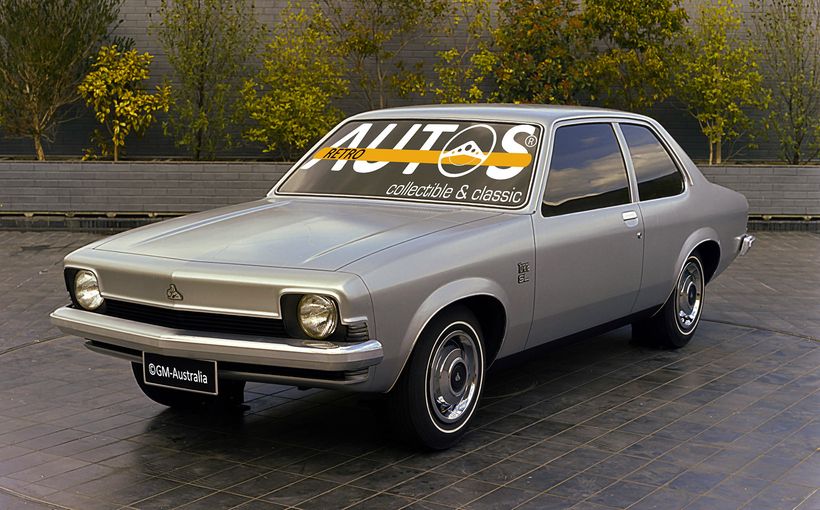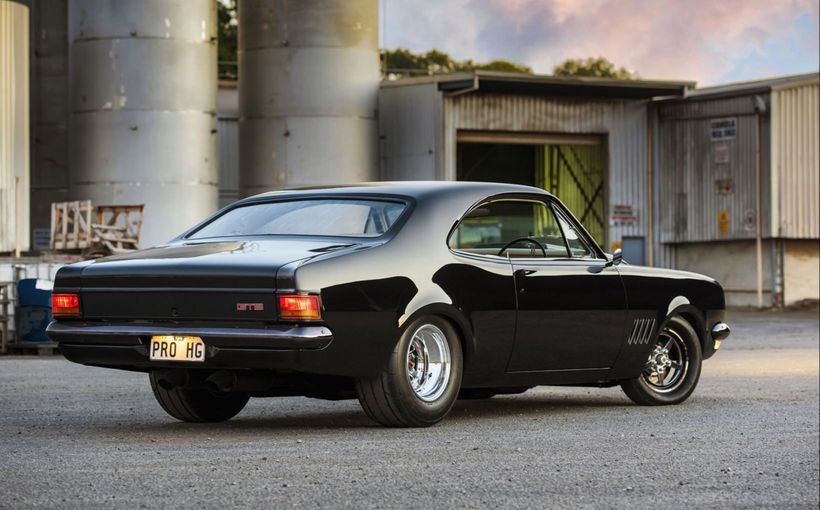1969 Holden LC Torana 6/GTR: Holden’s Finest 1960s Moment?

The local automotive industry was built on adapting overseas designs and making them work for Australia. Holden’s LC Torana GTR based on the under-performing Vauxhall HB Viva runabout must stand as the greatest and most successful transformation undertaken in Australia. Unlike other local adaptations, the LC Torana 6’s styling and powertrains were also totally unique to Australia.
It did more than define a new light six cylinder class in two and four door models. The two door version looked smart enough to be a serious sports coupe contender. It then generated an unprecedented record of track and rally successes unmatched by any local design since.
As the first and only 1960s Holden conceived and developed entirely in Australia, it hit bull’s eye. Holden’s huge investment in a local technical and design centre was money well-spent.
Its shock October 1969 arrival was greeted with disbelief. Although the first Monaro a year earlier was a radical step for Holden, it looked like what it was: a sleek roofline imposed over another square-rigged Holden family car.
The LC Torana 6 looked fast from nose to tail. Despite its many compromises, most of which were addressed over time, it was also a fun and agile car to drive. This was something that could never be said about any Holden six-cylinder or V8 up to this point. Even the top Monaros were hard work.

So how could the LC Torana 6 emerge from a company noted for its conservatism and resistance to change? The key influences were the best of what both the Americans and the Japanese were doing at the time. The LC Torana was the first chance for a new generation of young Australian designers mentored by visiting Americans to make their mark.
The LC Torana 6 placed the local operations of Ford, Chrysler and Leyland on notice. Superficially-tweaked overseas models would no longer cut it. It forced all three companies to assign extra priority to local design facilities.
It was only a matter of time before Holden’s full-size models would reflect the same design expertise. The LC Torana 6 played an important role in establishing a context for the best-selling HQ’s more sophisticated looks.
Holden’s New Small Car that Wasn’t
Australia in the early 1960s seemed to be preparing for the second coming. Media outlets milked the anticipation surrounding the arrival of Holden’s first small car: Holden was about to deliver a more compact version of its benchmark EH range. Or so everyone thought.
What arrived in April 1964 wasn’t even a Holden. “You’re kidding, the real small Holden is still to come” was the usual response. The Vauxhall HA Viva was not a bad car but it wasn’t a good one either. The Holden bits including bland Holden colours and tough, featureless trim made it look even stingier than it was.
The Viva was Vauxhall’s British translation of GM’s cynical bottom line thinking. By turning the quirkiness of its Ford Anglia rival into a bland, featureless box, Vauxhall reasoning was that the Viva couldn’t alienate anyone.

To compete with Ford’s low cost front strut suspension, the Viva had a simple wishbone front end with a transverse leaf spring. From there it could only get worse with external body seams, flat glass and panels. Its extra 60cc over the Anglia so it could just qualify as a 1.1-litre was its only saving grace. Brilliant for an East German Trabant update it might have been but a trail-blazing new small Holden it wasn’t.
Australians were not the only ones underwhelmed. The Brits didn’t like it either. Ford’s brilliant Cortina had caught Vauxhall sleeping. This was at a time when “Australia’s Own” still meant something. The motivation within Holden to make up for this huge breach of trust was an itch that wasn’t properly scratched until the LC Torana arrived.

The First Torana
The even crazier part about the HA Viva was that Vauxhall had learnt nothing from its failure. A red-faced and furious GM global styling chief Bill Mitchell rejected its equally bland replacement.
Mitchell’s solution was to haul later Holden design chief, a young Leo Pruneau, out of one of Detroit’s Advance Studios and send him to Vauxhall. Pruneau’s instructions were to make sure that the proposal he had earlier created for Mitchell as a Viva replacement went into production as the HB Viva.
It was an outstanding starting point for the LC Torana because of several firsts still largely unrecognized. The UK industry (and therefore Australia) was in the grip of Lucas as the main electrical component supplier. Lucas had a range of tack-on headlights, tail lights, parkers and indicators that dictated the design of a new British car. It’s why the tail of an Aston Martin could look like an Austin A40 Farina.
Mitchell, and therefore Pruneau, were having none of that. Detroit’s Advance Studios were now designing cars with tail lights that followed the styling, not the other way around. The HD Holden was the first local model which featured tail lights flush within the body that did not break the lines of the styling. Straight out of GM’s Advance Studios like Pruneau, the 1965 HD Holden was ahead of several of GM’s own US models.
Pruneau’s new HB Viva shape was not only the first small car with the curved sides and door frames and the new “coke bottle look” of the 1965 Chevrolet, it featured a variation of the HD’s wraparound, flush tail lights to make it look wider. To give his new Viva some real presence, Pruneau also insisted on bold rectangular headlights, a first for the UK but not Europe.
Pruneau had to play hard ball and find alternative electrical suppliers to get the lighting he wanted for his HB Viva design, a battle he would lose for his later Victor replacement (how he compensated for this would influence the LC Torana).
Pruneau’s HB cockpit style dash was also a big advance over the flat metal scuttle panels peppered with switches and gauges usually seen at this level. Seating at upper levels was as plush as the HA Viva’s was mean.
Under the skin, the HB Viva was no longer the bottom of the barrel. Its coil spring wishbone front end with its own subframe and four link, coil spring rear was a big step-up from the average rear drive small car. It reflected what was under Chevrolet and Ford’s biggest and most powerful models with rack and pinion steering as a bonus.
Unlike strut front ends which dictate costly structural change for major upgrades and leaf spring rear axles which suffer axle tramp under extra power, the HB Viva starting point was easily upgraded for big power increases.

On its September 1966 arrival on the UK market, the HB Viva turned the tables on the Cortina. In fact, Ford was struggling to source suitable tail lights to finish off its new Mark II Cortina. Pruneau’s new HB Viva suddenly made it easier hence the similarity between the two cars at the rear.
The HB Viva was a huge sales success and enjoyed a three year lead in styling. The styling of the first Escort and Cortina TC/Mark III were a direct result of the HB Viva’s success.
Unbelievably, Holden managed to turn the HB Viva into another HA Viva despite the new Torana badge on its May 1967 local release. Holden re-created the HA’s plain round headlight look by fitting another bland Holden grille with standard round headlights. This was at a time when new Japanese rivals such as the Isuzu Bellett and Mazda 1500 were fitting quad headlights in their sub-compact sedans.
If there was a moment in time that separated Holden and Ford for future dominance, it was this one. Ford would later preserve the rectangular headlights of its European Escort in local models and the affection this model generated was never extended to the HB Torana.
It was an act of unbelievable stupidity and cynical cost-cutting that set Holden up for failure in this segment until the Gemini arrived in 1975. The weak-looking front unnecessarily reinforced the weakness of the Torana fours under the bonnet.
One of the few bright sides to the HB Torana was Holden’s fast-tracking of Pruneau’s work on the four-door version so it arrived ahead of the British model.

The First Real Torana
Where to after the HB Torana was not immediately obvious. Pruneau’s new Vauxhall FD Victor four/Ventora six launched in 1967 was just as big a leap forward over the Cortina/Corsair and others as his HB Viva. It had the credentials to be the next Torana in the 1600 and over class but was too big and expensive for an entry four cylinder model.
As a mid-range Holden four and six, the Victor would have dictated a third vehicle line at a time when incentives to increase local content were stronger than ever.
Vauxhall’s HC Viva replacement for 1970 was not a solution either as its simpler, squarer style was not where Holden was heading after 1969. Holden had no choice but to go it alone with a variation of the HB Torana.
The lateral thinking that delivered the LC Torana demonstrated why Holden deserved another chance at the top.

The Challenges
The HB Torana was barely a year old when it was obvious that it would not be enough to head-off new 1.5-1.6-litre rivals. These had already killed off the locally manufactured Volkswagen 1300 Beetle by 1968 and the HB Torana was next with its feeble engines and cheapened appearance.
The late 1968 Series II HB Torana safety upgrade was a case of three steps forward and two steps back after the collapsible HK’s steering column killed off the more modern Vauxhall steering column’s switchgear.
The LC was supposed to be a simple mid-life facelift for the fours. That was until Holden management realized their only weapon under tougher local content requirements against the growing fours was a small six.
Holden’s young designers were acutely aware of European styling trends that placed the headlights beside a much narrower strip-style grille-opening as pioneered by overseas Peugeots, Ferraris, Fiat coupes and others. Holden had in fact defined this look in time for a 1969 release but astutely mothballed it until the 1974 LH Torana and 1975 TX Gemini.
An LC Torana proposal by local designer Peter Nankervis would have seen a revised HB Torana arrive in 1969 with a front identical to the LH Torana/TX Gemini. It didn’t surface because Assistant Director of Design, John Schinella, former Pontiac stylist and the man who completed the HK Monaro for 1968, believed that Holden and Australia were not yet ready.
Schinella was responsible for convincing Holden to define the LC-LJ Torana as a much wilder, sportier design with clear Pontiac GTO overtones. The internal debate was intense.
Peter Nankervis recalls Schinella defining his vision in abstract drawings that reflected what Pontiac was about to do with the GTO, then inviting young Australian designers to translate it into the HB Torana sheet metal. Pruneau’s pioneering earlier HB Viva work had ensured that the Torana architecture was the perfect starting point for a GTO-inspired restyle.
At this stage, it was recognised that the internal architecture of the HB Torana had to be re-engineered to create extra rear seat legroom and boot space. Finding space for the small sixes needed to head off growing rival fours was a bigger problem.

Holden’s switched-on local designers had kept an eye on the Prince Skyline GT, a car that started life as a small 1500 sedan then developed to house a bulky overhead cam inline six with triple Webers. They presented the Skyline as an example of what could be done to the HB Torana.
The fledgling Japanese industry must be given credit for validating an engineering approach that allowed Holden to proceed with the LC Torana four and six cylinder ranges. The Prince solution was to retain an identical Skyline body behind the windscreen while extending the wheelbase between the front door and front wheelarch.
Unlike Prince, Holden failed again on the four cylinder brief by not revising the HB Torana front to reflect the new found presence of the six-cylinder nose.
In yet another bout of cynicism and cost-cutting, the Torana four’s stub-nose and round headlight front now had to balance a sweeping new tail shared with the sixes. The Prince Skyline 1500 and GT, despite a similar boost in wheelbase to accommodate the GT’s six, had the same credibility at the front.
It was almost as if Holden wanted to fail in the four cylinder segment as there was no shortage of internal proposals to give the LC Torana fours a strong presence of their own.
The March 1974 TA Torana which finally addressed this, was ready to go as early as 1969 but instead was rolled out in the LC body’s final year. The TA Torana demonstrated, without a single sheet metal change, that the LC Torana four did not have to go to market in 1969 looking like a large chunk was missing at the front.
The amazing LC Torana 6 not only succeeded in making the average four cylinder buyer feel short-changed, Holden allowed it to do the same to its own LC Torana 4 stablemate! Go figure!

After Holden succeeded in scaling-down Pontiac GTO styling so that it looked fresh and right as Holden’s latest small car, it was the automotive equivalent to an America’s Cup win. It was a huge boost to Australia’s Gross National Confidence at a time when other local cars were starting to look tired.
The LC GTR Solution
It was the LC Torana 6’s new nose that made it much more than a wheelbase stretch. Pruneau’s HB Viva not only had the lines to carry an aggressive extended nose, the bonnet shape also allowed for the Pontiac-style centre division that Schinella was pushing for.
The compromise was to replace the traditional Pontiac centre-grille division with an extended centre section that gave the Torana the shark-nosed profile loved by so many fans. After quad headlight and hidden headlight proposals were shelved, local designers Peter Nankervis and Phil Zmood both came up with square headlight pods to restore the strong, solid look of Pruneau’s HB Viva.
Pruneau had just been forced to do the same after his British bosses wouldn’t pay for the rectangular headlights he wanted for his new Vauxhall Victor. The local LC Torana 6 solution was consistent with his work.
The other big change was opening up the sheet metal below the front bumper and sloping what was left back to the front wheels. This broke-up the acreage of paint below the Torana 4’s front bumper that added to its tall, skinny look.
The icing on the cake was the detailed mesh grille that wrapped around the sides to create the illusion of extra width. The break in the side extensions then continued as a Chevrolet Malibu SS-style body-colour fill across the centre of the grille. Australians had never seen such detail in a local grille, especially at entry level.
The LC Torana 6’s pressed aluminium grille is at last being recognized as the intricate original and the LJ’s plastic egg-crate as the cost-cutter.

From there, it was even better. The HB Viva’s curved sides allowed Schinella and his team to merge the C-pillar into the rear quarters and boot line without a step.
This smooth new look had only just emerged in the first Monaro a year earlier, and already it was in an entry level family car. Because the HT facelift gave full-sized Holdens a similar look, it confirmed that the LC Torana 6 was indeed the small Holden promised in 1964.
Yet it didn’t stop there either. Pruneau’s flush HB tail lights were extended across the rear, again adding to the impression of extra width. Accent lines across the tail light lenses of the top level Toranas including the GTR forged a direct link with full-sized Monaros and Premiers.
The 13 inch wheels filled out the wheelarches and gave the Torana 6 a tough, all road look. The GTR’s trim rings were the best ever seen on a production car (or in any speed shop) as their angled surfaces caught the light. They became a hot theft item overnight. A neat touch was the blast of silver frost over the GTR’s exposed black wheels to distract the eye from the beefed-up centres and hub cap nibs.

Last but not least was the cabin, especially the GTR. Prior to John Schinella’s arrival at Holden, popular husband and wife team Ted and Marjorie Schroeder, also from the US, had a profound influence on the first Monaro. As Ted Schroeder re-defined the first Monaro’s look with Oldsmobile Toronado cues, his wife, an interior specialist, introduced exciting new stitch patterns and fabrics.
The Schroeders’ legacy was winning over the old guard within Holden to fund these changes with the promise of extra sales. They had opened an envelope for Holden’s young designers to do something special for the LC GTR. The rocket-style door trims and box section pleats across the seats delivered a cabin as wild as the exterior.
Because Phil Zmood, Paul Beranger and Peter Nankervis were regularly rotated between the small and large car teams, it was straightforward to add Monaro GTS cues to the GTR cabin and exterior to keep it all in the family.
The HB Viva’s swoopy dash design was a more intimate and attractive setting for the GTR’s full instrument pack and sports steering wheel than the larger Holdens. Only the absence of a space for a radio revealed its British budget car origins.
The LC Torana 6 won the 1969 Wheels Car of the Year and the GTR was highly praised for its value and performance. For just $2800 or $400 under the Capri V6, the GTR was almost as fast posting a standing quarter of 17.5 seconds and a top speed of 107mph/171km/h. As for looks, it was a generation ahead of most Japanese and European rivals.

Under the Skin
The 186S hot-up bits that appeared later in the HR model run, were transferred to the smaller 161 engine to create the 2600S for the GTR. Torana 6 engines always carried metric badging aligned with the fours. Despite the twin-branch exhaust headers, twin throat carburettor, mild camshaft, stronger valve springs and slotted air cleaner of the 2600S, a stock 186 delivered more power without the drama.
But the GTR’s job was to add glitter to the smaller Torana sixes, not shame them. From July 1971, the HQ and LC’s new entry six was the 173/2850 so the 186S bits were again applied to create a unique 2850S for the LC GTR. This boosted power from 125bhp/93kW to 130bhp/97kW for a worthwhile improvement.
The old Opel 4-speed manual gearbox with its ropey linkages and gap between 2nd and 3rd (first seen behind the HR’s 186S) was combined with the 2600S of the early LC GTR. The much better Australian four-speed M20 developed from Holden’s three-speed arrived as a running change with the 2850S but it needed the close-ratios of the XU-1’s M21.

The wide and heavy 13 inch wheels were a tight fit in wheelhouses designed for 12 inch Viva wheels. Coupled with the bigger rubber and extra beef in every suspension part and axle, there just wasn’t enough suspension travel to pull up all this extra unsprung weight on rough roads for a progressive ride.
Holden instead relied on stiff damper rates and bump stops to keep it in check but such abrupt suspension control combined with old school wire-spring seat bases would often launch occupants’ heads into the rooflining.
The bump steer over broken surfaces was a greater concern with the standard square-walled cross-ply tyres which needed no excuse to let go without warning. Radials were a must-have extra-cost option.
Because Holden’s structural engineers had done their job, the Torana 6 had the unbreakable feel of larger Holdens so these early shortfalls were not enough to dampen enthusiasm for the new model.
Favourable comparisons between the LC GTR and Ford’s new Capri in both four and V6 specifications had an even bigger impact on four door Torana sales as it suggested you could have four door sedan practicality and coupe sportiness in the one package.
But there was one critical area that Holden never addressed in any LC or LJ Torana 6. Hanging onto an early GTR was never easy as it became top of the pops for young car thieves. The HB Torana may never have needed a bonnet lock or vent window locks but their absence on an LC GTR was seen as an open invitation. It was one of the many factors that have made an LC Torana GTR such a rare sight today!
Protect your Holden. Call Shannons Insurance on 13 46 46 to get a quote today.
Reference: Torana Tough by Norm Darwin









